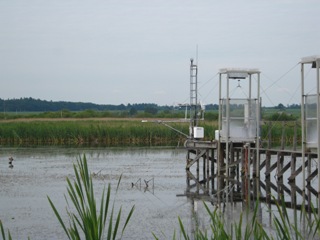Mar 27 2015
Natural wetlands usually emit methane and sequester carbon dioxide. Anthropogenic interventions, in particular the conversion of wetlands for agriculture, result in a significant increase in CO2 emissions, which overcompensate potential decreases in methane emission.
 Automatic flux measurement chambers and an eddy covariance system to determine turbulent exchange fluxes of heat, water vapor, CO2, and CH4 between a re-wetted peatland and the atmosphere at Zarnekow, NE Germany (photo: Daniela Franz, GFZ)
Automatic flux measurement chambers and an eddy covariance system to determine turbulent exchange fluxes of heat, water vapor, CO2, and CH4 between a re-wetted peatland and the atmosphere at Zarnekow, NE Germany (photo: Daniela Franz, GFZ)
A large international research team now calculated that the conversion of arctic and boreal wetlands into agricultural land would result in an additional cumulative radiative forcing of about 0,1 MilliJoule (mJ) per square meter for the next 100 years. The conversion of temperate wetlands into agricultural land would even result in a cumulative radiative forcing of 0,15 mJ per square meter. Converting forested wetlands into managed forests also contributes to increased warming, albeit much less than the conversion of non-forested wetlands.
Wetlands are unique ecosystems, which - under natural conditions - are the single largest natural source of the greenhouse gas methane (CH4) but at the same time an important sink for the greenhouse gas carbon dioxide (CO2). The climate footprint of these ecosystems depends on the balance of these two important greenhouse gases. Despite methane being 28 times more potent as a greenhouse gas than carbon dioxide (in a 100 year time span), the conversion of natural wetlands into agricultural or forested ecosystems and its associated decrease in methane emissions still leads to an overall warming effect. „The human impact on wetlands, such as drainage, results in a shift of the climate footprint of that wetland" says Torsten Sachs at the GFZ German Research Centre for Geosciences, co-author of the study. „The overall balance of these two differently active greenhouse gases and thus the climate footprint of a wetland over different time spans depend on the relative sign and magnitude of these ecosystem-atmosphere fluxes."
The global impact is still rather uncertain due to large temporal and spatial variability and a lack of data on the complex interactions between environmental drivers such as temperatures of land, water, and sediment, water levels, vegetation, nutrient availability, among others, and the additional anthropogenic impacts such as land use change.
To calculate the net ecosystem carbon balance of wetland ecosystems, the more than 40 member research team synthesized data from almost 30 differently affected arctic, boreal, and temperate study sites across the globe. Simultaneous measurements of the ecosystem-atmosphere CO2 and CH4 fluxes in continental North America, Greenland, Europe, and Russia were used for analyses and modeling. For sites with a full annual dataset of CO2 and CH4 fluxes, natural and converted sites were paired in all possible combinations within similar ecosystem types. „To determine the climate impact of the conversion, we used the difference of the net ecosystem carbon balance between the site pairs as series of consecutive annual mass pulses and integrated their effect on tropospheric greenhouse gas concentrations" explains GFZ researcher Sachs. The different radiative efficiencies and atmospheric residence times of the greenhouse gases were accounted for when the radiative forcing was calculated for the period from 2000 - 2100.